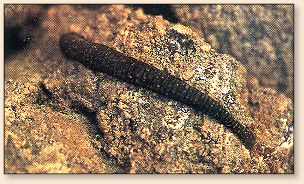|
Mention leeches and be prepared for a
variety of responses. Most people's faces
wince and contort in disgust, like fingers
down a chalkboard. Let's face it, leeches
suffer from a lousy reputation. Portrayed
as maniacal bloodsuckers it's not surprising
that most people find them appalling. To the
stillwater fly-fisher though, leeches stir a
different reaction. When I think of leeches,
a sly smirk comes across my face, recalling
memories of jarring takes and knuckle-dusting
runs.
Leeches have a worldwide distribution and are
a favorite trout food. In North America there
are over 63 species of leeches. For any angler
exploring a lake for the first time, leech
patterns are a great place to start even if
other food sources appear available. From the
evening light to the summer doldrums leeches are
an all-day, year-round food source. Leeches are
a basic pattern in any stillwater fly box. Never
leave home without them.

Leeches are distant cousins to the common earthworm
and not all species of leeches are freshwater
inhabitants. Some species of leeches are native
to both salt water and brackish marshes. Referred
to as dorso-ventrally flattened, leeches have
segmented ribbon bodies characterized by a narrow
head and paddle-like rear end. Located at each end
of a leech's body are posterior and anterior suckers.
Leeches use these suckers to leap frog their way
along the bottom debris and structure. The anterior
sucker also serves for feeding. Fully extended
leeches can reach over 8 inches in length, although
2 to 4 inches are more common. Trout seem to show
a preference for smaller leeches. The leech's
muscular body provides support and locomotion.
Leeches are powerful swimmers that move with a
steady, graceful, rhythmic motion. They swim fully
extended but when threatened contract into a
defensive ball.
Leeches are blind but have an acute sense of smell
and touch which they put to good use when foraging.
Like scuds, leeches have no emergence of any kind.
Trout become accustomed to this year-round leech
dessert. Nobody seems to know for sure how long
leeches live, but all agree it is a long time.
Many species have life spans of over 5 years.
During their life, leeches have many opportunities
to mate. Leeches are a big-ticket food item trout
seldom pass up.
Leeches are hermaphroditic, possessing both male
and female sex organs. Any two leeches can start
a family. Mating in pairs throughout the year,
leeches coil around themselves in an almost
passionate embrace. Once mating is complete
the leech places the cocoon eggs on weeds,
rocks and other debris. Upon hatching, the
newborn leeches are on their own, fending for
themselves.

Leeches come in a smorgasbord of colors. Black,
brown, maroon and olive are common. I have seen
olive-green leeches with yellow spots, black and
tan leeches even green with an orange racing stripe.
Lateral stripes and mottled color schemes in
conjunction with a lighter underbelly are common.
Leeches are hardy creatures capable of surviving
in diverse habitats. Favorite stomping grounds
include, mud, sunken logs, rocks and vegetation.
Leeches often burrow into the mud leaving their
heads exposed. Here they undulate back and forth
as though being soothed by some mystic snake
charmer. Tannic or algae type lakes are prime
habitats and often have enormous densities of
leeches. These are not places for taking a
refreshing dip. Leeches can survive at almost
any depth although 10 to 50 feet is normal,
making them an ideal quarry to imitate with
the fly. Naturally shy and reclusive leeches
prefer to sulk in the shadows during the height
of the day. They are primarily nocturnal,
venturing out to feed once the sun has left
the water. Leech patterns are an ideal choice
late in the day or during the evening. At times,
leeches swim boldly about in full view of the
trout. This suicidal bravado does not go
unnoticed.

Depending upon the species, leeches
have a varied diet. Despite their reputation,
only some species are bloodsuckers. These vampire
species latch onto amphibians, waterfowl and yes,
even unsuspecting humans. Others feed on carrion,
detritus, mollusks and snails. Even other leeches.
I have seen an immature leech attach itself to
the head of a large dragon nymph as a handy food
stop. It is interesting to see how fast a snail
moves when a curious leech shows up on its doorstep.
~ PR
More on food opportunities for trout in lakes from Phil Rowley's excellent book,
Fly Patterns for Stillwaters next time.
Credits: Excerpt from Fly Patterns
for Stillwaters By Philip Rowley, published
by Frank Amato Publications. We appreciate use
permission.
|




